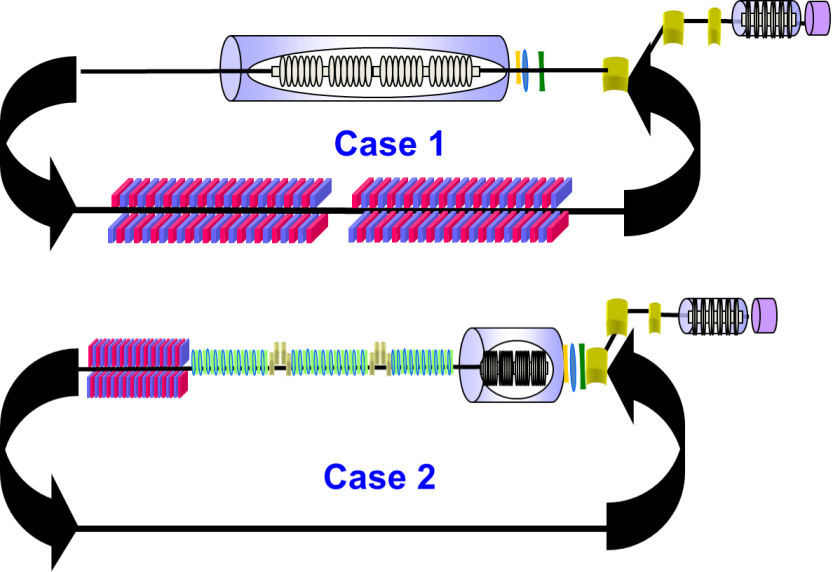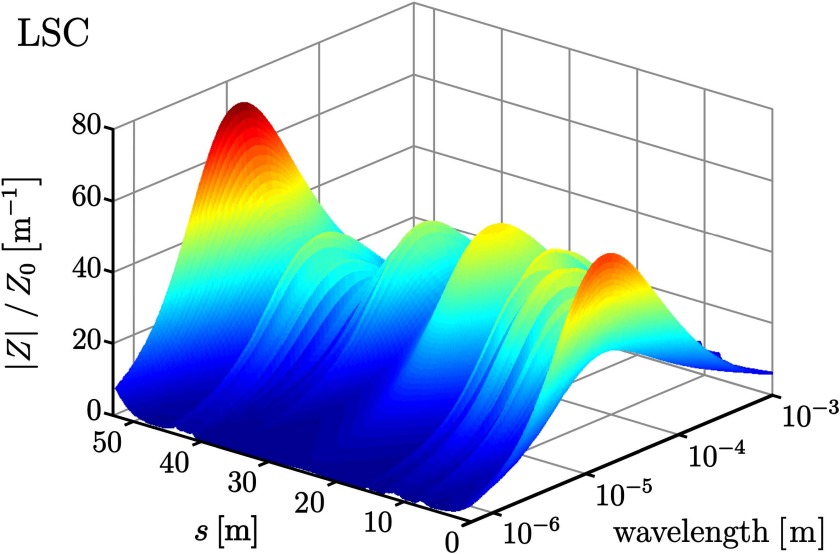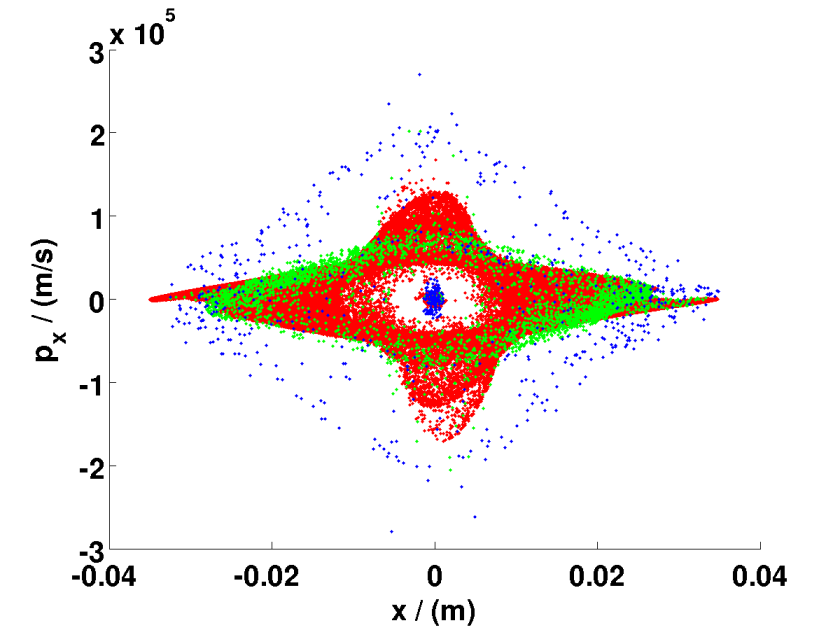Department Accelerator Operation, Development and Technology
Working Group: High Brightness Photon Beams
Synchrotron radiation facilities are designed to produce high intensity radiation by the means of high energetic electron or positron beams. During the last decades, these accelerator based radiation sources had become more and more the premier-research tool to explore the structure of the matter. Nowadays, synchrotron radiation facilities are providing radiation in ever more useful forms to a steadily growing number of experiments in a variety of disciplines, such as chemistry, biology, crystallography and physics.
The working group High Brightness Photon Beams (HBPB) develops advanced design concepts for accelerator based radiation sources. Currently, the research work of the group focuses on the one hand on advanced-radiation generation-concepts and on the other hand on investigation and mitigation of nonlinear effects which degrade the electron beam and thus the radiation quality.
Radiation Generation for ERL Facilities
The high repetition rate and high brightness of the delivered electron beams are outstanding features that make Energy Recovery Linacs (ERLs) ERLs desirable drivers for high brightness radiation sources. Utilizing conventional insertion devices, ERLs have the potential to reach high spectral brightness and high spatial coherence, exceeding the performance of today’s third generation storage rings while simultaneously offering much larger flexibility in the pulse duration between 2 ps and below 100 fs. In addition to the spontaneous synchrotron radiation generated in the insertion devices, an ERL may also provide radiation with a significantly higher flux-per-pulse by including a free-electron laser (FEL). FEL oscillators requiring comparatively low peak currents are often proposed for FEL sources in ERLs. However, single-pass FELs in SASE or seeded mode do not seem out of reach when bunch-compression schemes for higher peak currents are utilized. In addition to the FEL-instability other instabilities such as longitudinal space charge (LSC) driven microbunching instability can be envisaged for production of coherent radiation with high intensity. Of course in order to utilize a promising instability its occurrence and strength in a specific accelerator setup has to be carefully investigated. Thus in this context a detailed analysis and deep understanding of LSC is mandatory. Development of concepts for coherent radiation sources driven by ERLs is currently one of the main research objectives of the working group.
Last Publications:
- S.D. Rädel, On space charge driven microbunching instability in bERLinPro, PhD-thesis 2017, DOI
- S.D. Rädel, A. Jankowiak and A. Meseck, Investigation of Microbunching-Instability in bERLinPro, Proceedings of IPAC2014, Dresden, Germany, pp. 1662 JACoW.org
- A. Meseck et al., X-Ray FELs Based on ERL Facilities, Proceedings of FEL2011, Shanghai, China, pp. 111 JACoW.org
- A. Meseck, G.H. Hoffstaetter, F. Löhl and C.E. Mayes, FELs as X-Ray Source in ERL Facilites, Proceedings of PAC2011, New York, USA, pp. 2390 JACoW.org
Collaborations:
Ion Effects in ERLs
Energy Recovery Linacs are promising candidates for next-generation light sources now under active development. An optimal performance of these machines requires the preservation of the high beam brightness generated in the injector. Entering a new CW high current regime, bERLinpro facility is very sensitive to the impact of the trapped ions. The trapped ions can lead to a variety of degrading effects such as charge neutralization, emittance blowup, beam halo or even instabilities. The detailed investigation of ion effects in bERLinPro with the objective to deduce appropriate measures for the design and operation of bERLinPro is an important research objective of the working group. Currently, we are investigating the impact of the electrode shapes on the ion motion on the one hand and developing a method to include the impact of trapped ions in the particle tracking programs on the other hand. For this we are collaborating with the University of Rostock, University of Bonn and COMPAEC e.G
Last Publications:
- G. Pöplau, A. Meseck, Investigation on the ion motion towards clearing electrodes in an accelerator, Proceedings of IPAC2017, Copenhagen, Denmark, JACoW.org
- G. Pöplau, U. Van Rienen and A. Meseck, Numerical studies of the behavior of ionized residual gas in an energy recovering linac,
Phys. Rev. ST Accel. Beams 18, 044401 (2015) (Editors’ Suggestion) - E. Brentegani et al., Simulation of the Distribution of Parasitic Ions in the Potential of an Electron beam, Proceedings of ICAP2015, Shanghai, China, JACoW.org
- D. Sauerland et al., Estimation of the Ion Density in Accelerators using the Beam Transfer Function Technique, Proceedings of IPAC2015, Richmond, VA, USA, JACoW.org
- D. Sauerland et al., First Studies on Ion Effects in the Accelerator ELSA, Proceedings of IPAC2014, Dresden, Germany, pp. 1585 JACoW.org
- A. Markoviḱ et al., Dynamics of Ion Distributions in Beam Guiding Magnets, Proceedings of IPAC2014, Dresden, Germany, pp. 1668 JACoW.org
- G. Pöplau et al., Numerical Studies on the Impact of Ionized Residual Gas on an Electron Beam in an ERL, Proceedings of IPAC2013, Shanghai, China, pp. 903 JACoW.org
- G. Pöplau et al., Simulations for Ion Clearing in an ERL, Proceedings of ICAP2012, Rostock-Warnemünde, Germany, pp. 143 JACoW.org
- A. Meseck et al., Numerical Studies on the Influence of Fill Patterns on Ion Clouds, Proceedings of ICAP2012, Rostock-Warnemünde, Germany, pp. 146 JACoW.org
- G. Pöplau et al., Simulations of the Behavior of Ionized Residual Gas in the Field of Electrodes, Proceedings of IPAC2012, New Orleans, USA, pp. 283 JACoW.org
Collaborations:
- Verbundforschung MILOS: "Experimentelle Verifikation von Maßnahmen zur Milderung von Ioneneffekten in Hochstrombeschleunigern"
- Physikalisches Institut der Universität Bonn, Elektronen-Stretcher-Anlage ELSA, University Bonn, Germany website
- Institut für Allgemeine Elektrotechnik, University Rostock, Germany website
High Intensity Radiation in EUV and Soft X-Ray Range
“Beyond EUV (BEUV) lithography” at wavelengths shorter than 7 nm demands a source providing very high intensity with a very small bandwidth at lowest possible etendue. Accelerator based sources have been brought into discussion as suitable sources. However, for the conceptional design the special requirements imposed by driving a lithography tool have to be taken into account properly. The working group investigates possible schemes and the prospects of accelerator based sources for lithography application.
Last Publications:
- A.Meseck, Accelerator Based EUV Sources, PTB-Seminar : 290.VUV and EUV Metrology 2015, BERLIN Germany, Talk
- A. Meseck, Accelerator-based EUV lithography source: FEL-oscillator, SASE-FEL, or avery different beast?, SPIE Advanced Lithography Conference 2014, San Jose (California, USA) 2014
- D. Türke et al., Concept Study on an Accelerator Based Source for 6.x nm Lithography, International Workshop on EUV and Soft X-Ray Sources 2012, Dublin, Irelan Talk
Collaborations:
- Carl Zeiss Semiconductor Manufacturing Technology GmbH website
Collaborative Research
In collaboration with national and international universities and research centers, the working group develops design concepts for accelerator based radiation sources and investigates collective phenomena in accelerator.
Topics:
- SRF THz Source, University of Uppsala FEL2014
- Laser-Plasma-Driven Free-Electron Laser Physical Review
- Space-Charge Effects in Accelerators Cornell Acc. Seminar
Concepts for LINAC-driven Seeded FELs and Simulations Codes
In the context of FEL studies, the group has developed and upgraded several numerical codes. These codes are available as open-source-codes for colleagues all over the world. The simulation codes developed by the group (essential upgrades of GENESIS making simulations on seeding possible, an HHG-code and an space charge code) have been employed in designing crucial experiments at modern FELs.
Project list:
- BESSY Soft X-Ray FEL - Technical Design Report - HZB
- STARS - Proposal for the Construction of a Cascaded HGHG FEL - HZB
- ORS - Optical Replica Synthesizer
- FLASHII - Extension for the Free Electron Laser in Hamburg - DESY



